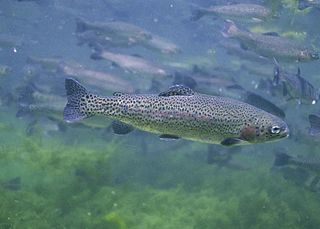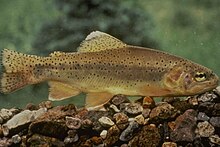
Trout is a generic common name for numerous species of carnivorous freshwater ray-finned fishes belonging to the genera Oncorhynchus, Salmo and Salvelinus, all of which are members of the subfamily Salmoninae in the family Salmonidae. The word trout is also used for some similar-shaped but non-salmonid fish, such as the spotted seatrout/speckled trout.

The Gila River is a 649-mile-long (1,044 km) tributary of the Colorado River flowing through New Mexico and Arizona in the United States. The river drains an arid watershed of nearly 60,000 square miles (160,000 km2) that lies mostly within the U.S., but also extends into northern Sonora, Mexico.

The rainbow trout is a species of trout native to cold-water tributaries of the Pacific Ocean in Asia and North America. The steelhead is an anadromous (sea-run) form of the coastal rainbow trout(O. m. irideus) or Columbia River redband trout (O. m. gairdneri) that usually returns to freshwater to spawn after living two to three years in the ocean. Freshwater forms that have been introduced into the Great Lakes and migrate into tributaries to spawn are also called steelhead.

The cutthroat trout(Oncorhynchus clarkii) is a fish species of the family Salmonidae native to cold-water tributaries of the Pacific Ocean, Rocky Mountains, and Great Basin in North America. As a member of the genus Oncorhynchus, it is one of the Pacific trout, a group that includes the widely distributed rainbow trout. Cutthroat trout are popular gamefish, especially among anglers who enjoy fly fishing. The common name "cutthroat" refers to the distinctive red coloration on the underside of the lower jaw. The specific name clarkii was given to honor explorer William Clark, coleader of the Lewis and Clark Expedition.

The Californiagolden trout (Oncorhynchus aguabonita or Oncorhynchus mykiss aguabonita) is a species of trout native to California. The golden trout is normally found in the Golden Trout Creek, Volcano Creek, and the South Fork Kern River. The Golden trout is the official freshwater state fish of California since 1947.

The Apache trout or Arizona trout, is a species of freshwater fish in the salmon family of order Salmoniformes. It is one of the Pacific trouts.

Oncorhynchus is a genus of ray-finned fish in the subfamily Salmoninae of the family Salmonidae, native to coldwater tributaries of the North Pacific basin. The genus contains twelve extant species, namely six species of Pacific salmon and six species of Pacific trout, all of which are migratory mid-level predatory fish that display natal homing and semelparity.

Lahontan cutthroat trout is the largest subspecies of cutthroat trout, and the state fish of Nevada. It is one of three subspecies of cutthroat trout that are listed as federally threatened.
Aldo Leopold Wilderness, along with Gila Wilderness and Blue Range Wilderness, is part of New Mexico's Gila National Forest. It became part of the National Wilderness Preservation System in 1980 by an act of the United States Congress and has a total of 202,016 acres (81,753 ha). The wilderness area lies along the crest of the Black Range.

The roundtail chub is a cyprinid fish in the genus Gila, of southwestern North America. It is native to the Colorado River drainage basin, including the Gila River and other tributaries, and in several other rivers. It is part of the "robusta complex", which includes the Gila robusta robusta, G.r. grahami, and G.r. seminuda.

The Colorado River cutthroat trout is a subspecies of cutthroat trout native only to the Green and Colorado River basins, which are west of the Continental Divide. Cutthroat trout found in other river basins belong to other subspecies.

The greenback cutthroat trout is the easternmost subspecies of cutthroat trout. The greenback cutthroat, once widespread in the Arkansas and South Platte River drainages of Eastern Colorado and Southeast Wyoming, today occupies less than 1% of its historical range. It is currently listed as threatened under the Endangered Species Act. It was adopted as the state fish of Colorado on March 15, 1994, replacing the unofficial rainbow trout.

Gila Wilderness was designated the world's first wilderness area on June 3, 1924. Along with Aldo Leopold Wilderness and Blue Range Wilderness, the 558,014 acre wilderness is part of New Mexico's Gila National Forest. The wilderness is approximately 27 miles (43 km) from north to south and 39 miles (63 km) east to west.

The bonytail chub or bonytail is a cyprinid freshwater fish native to the Colorado River basin of Arizona, California, Colorado, Nevada, New Mexico, Utah and Wyoming in the southwestern United States; it has been extirpated from the part of the basin in Mexico. It was once abundant and widespread in the basin, its numbers and range have declined to the point where it has been listed as endangered since 1980 (ESA) and 1986 (IUCN), a fate shared by the other large Colorado basin endemic fish species like the Colorado pikeminnow, humpback chub, and razorback sucker. It is now the rarest of the endemic big-river fishes of the Colorado River. There are 20 species in the genus Gila, seven of which are found in Arizona.
The Mexican golden trout is a species of fish in the family Salmonidae. The species is endemic to high-elevation headwaters of the Fuerte River, Sinaloa River, and Culiacán River drainages in the Sierra Madre Occidental in Mexico.

Oncorhynchus masou formosanus, commonly known as the Formosan salmon, Taiwanese trout, Tsugitaka trout, Lishan trout or Slamaw trout, is an endangered freshwater fish endemic to the mountain stream valleys between the Xueshan and Central Ranges of Taiwan. It is the southernmost subspecies of masu salmon, and one of the most temperately distributed salmonids along with the Mexican golden trout and Mexican rainbow trout.

The Sonora Sucker, Catostomus insignis, is a medium-sized catostomid fish with 16 other species in the genus scattered throughout North America. This species is remarkably similar in appearance to the Yaqui Sucker.

The Arizona Mountains forests are a temperate coniferous forests ecoregion of the southwest United States with a rich variety of woodland habitats and wildlife.
Mexican native trout —Mexican rainbow trout, sometimes Baja rainbow trout and Mexican golden trout —occur in the Pacific Ocean tributaries of the Baja California peninsula and in the Sierra Madre Occidental of northwestern Mexico as far south as Victoria de Durango in the state of Durango. Many forms of the Mexican rainbow trout, subspecies of the rainbow trout, have been described. The Mexican golden trout is a recognized species.

The Little Kern golden trout is a brightly colored subspecies of rainbow trout native to the main stem and tributaries of the Little Kern River in Tulare County, California. Together with the California golden trout and the Kern River rainbow trout, the Little Kern golden trout forms what is sometimes referred to as the "golden trout complex" of the Kern River basin.



















